Workplace Mental Health: Analysis of Programs and Implementation
VerifiedAdded on 2023/06/10
|12
|2847
|127
Report
AI Summary
This report provides a comprehensive analysis of mental health and wellbeing programs in the workplace, focusing on organizations such as the University of Birmingham, Victoria Police Force, and Link Health and Community. It identifies key components of mental health programs, including policy development, creating supportive environments, and encouraging employee participation. The report examines specific programs like Beyondblue and Mental Health First Aid, as well as Employee Assisted Programs (EAPs) and Health Promotion Programs (HPPs). It also addresses the importance of cultural and gender-specific considerations in program design. Furthermore, the report details the development of a mental health and wellness program for a hypothetical company, including the roles of senior managers, supervisors, and team members, and outlines goals, outcomes, key needs, and evaluation methods for the program. The report concludes by emphasizing the significance of aligning organizational culture with mental health objectives and implementing thorough program evaluations to ensure effectiveness.
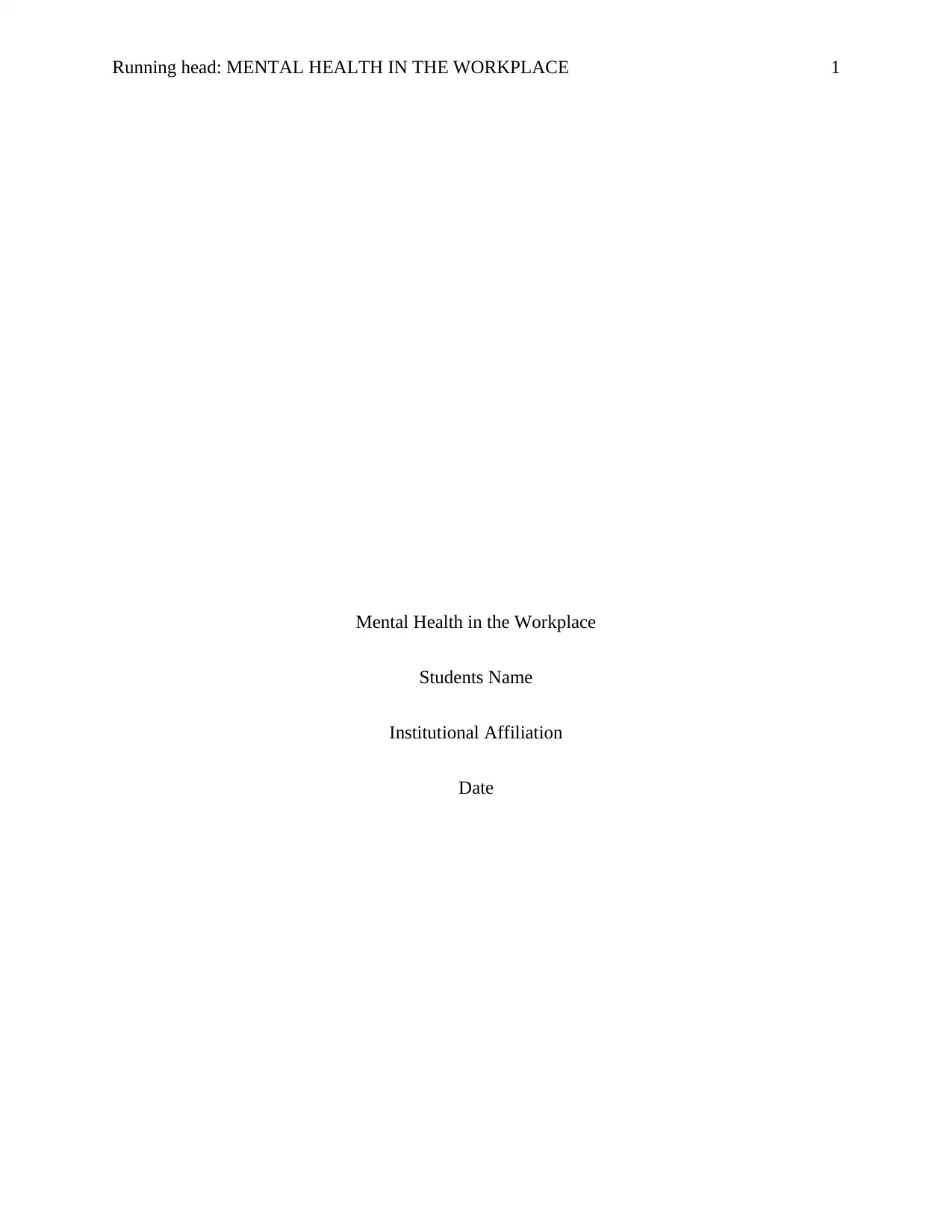
Running head: MENTAL HEALTH IN THE WORKPLACE 1
Mental Health in the Workplace
Students Name
Institutional Affiliation
Date
Mental Health in the Workplace
Students Name
Institutional Affiliation
Date
Paraphrase This Document
Need a fresh take? Get an instant paraphrase of this document with our AI Paraphraser
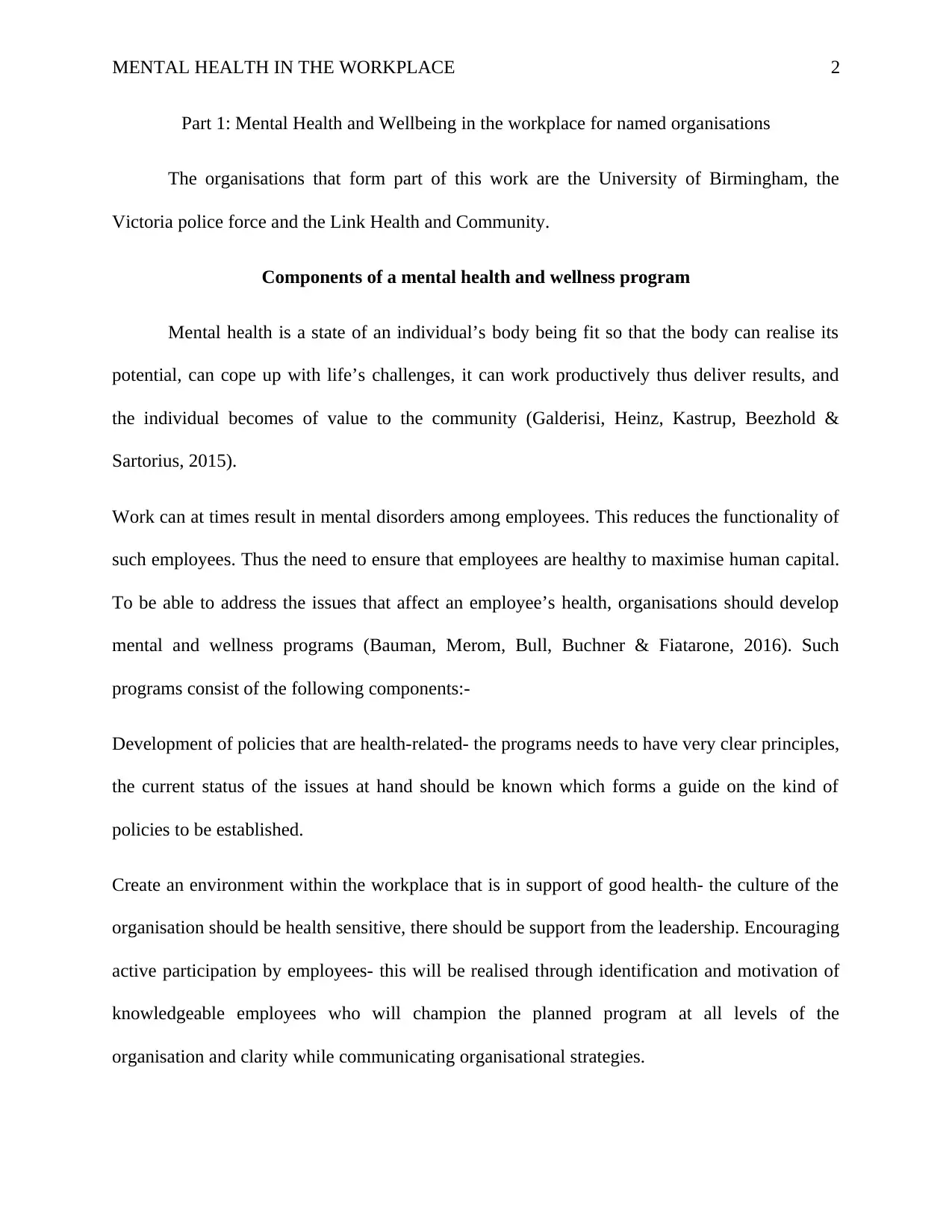
MENTAL HEALTH IN THE WORKPLACE 2
Part 1: Mental Health and Wellbeing in the workplace for named organisations
The organisations that form part of this work are the University of Birmingham, the
Victoria police force and the Link Health and Community.
Components of a mental health and wellness program
Mental health is a state of an individual’s body being fit so that the body can realise its
potential, can cope up with life’s challenges, it can work productively thus deliver results, and
the individual becomes of value to the community (Galderisi, Heinz, Kastrup, Beezhold &
Sartorius, 2015).
Work can at times result in mental disorders among employees. This reduces the functionality of
such employees. Thus the need to ensure that employees are healthy to maximise human capital.
To be able to address the issues that affect an employee’s health, organisations should develop
mental and wellness programs (Bauman, Merom, Bull, Buchner & Fiatarone, 2016). Such
programs consist of the following components:-
Development of policies that are health-related- the programs needs to have very clear principles,
the current status of the issues at hand should be known which forms a guide on the kind of
policies to be established.
Create an environment within the workplace that is in support of good health- the culture of the
organisation should be health sensitive, there should be support from the leadership. Encouraging
active participation by employees- this will be realised through identification and motivation of
knowledgeable employees who will champion the planned program at all levels of the
organisation and clarity while communicating organisational strategies.
Part 1: Mental Health and Wellbeing in the workplace for named organisations
The organisations that form part of this work are the University of Birmingham, the
Victoria police force and the Link Health and Community.
Components of a mental health and wellness program
Mental health is a state of an individual’s body being fit so that the body can realise its
potential, can cope up with life’s challenges, it can work productively thus deliver results, and
the individual becomes of value to the community (Galderisi, Heinz, Kastrup, Beezhold &
Sartorius, 2015).
Work can at times result in mental disorders among employees. This reduces the functionality of
such employees. Thus the need to ensure that employees are healthy to maximise human capital.
To be able to address the issues that affect an employee’s health, organisations should develop
mental and wellness programs (Bauman, Merom, Bull, Buchner & Fiatarone, 2016). Such
programs consist of the following components:-
Development of policies that are health-related- the programs needs to have very clear principles,
the current status of the issues at hand should be known which forms a guide on the kind of
policies to be established.
Create an environment within the workplace that is in support of good health- the culture of the
organisation should be health sensitive, there should be support from the leadership. Encouraging
active participation by employees- this will be realised through identification and motivation of
knowledgeable employees who will champion the planned program at all levels of the
organisation and clarity while communicating organisational strategies.
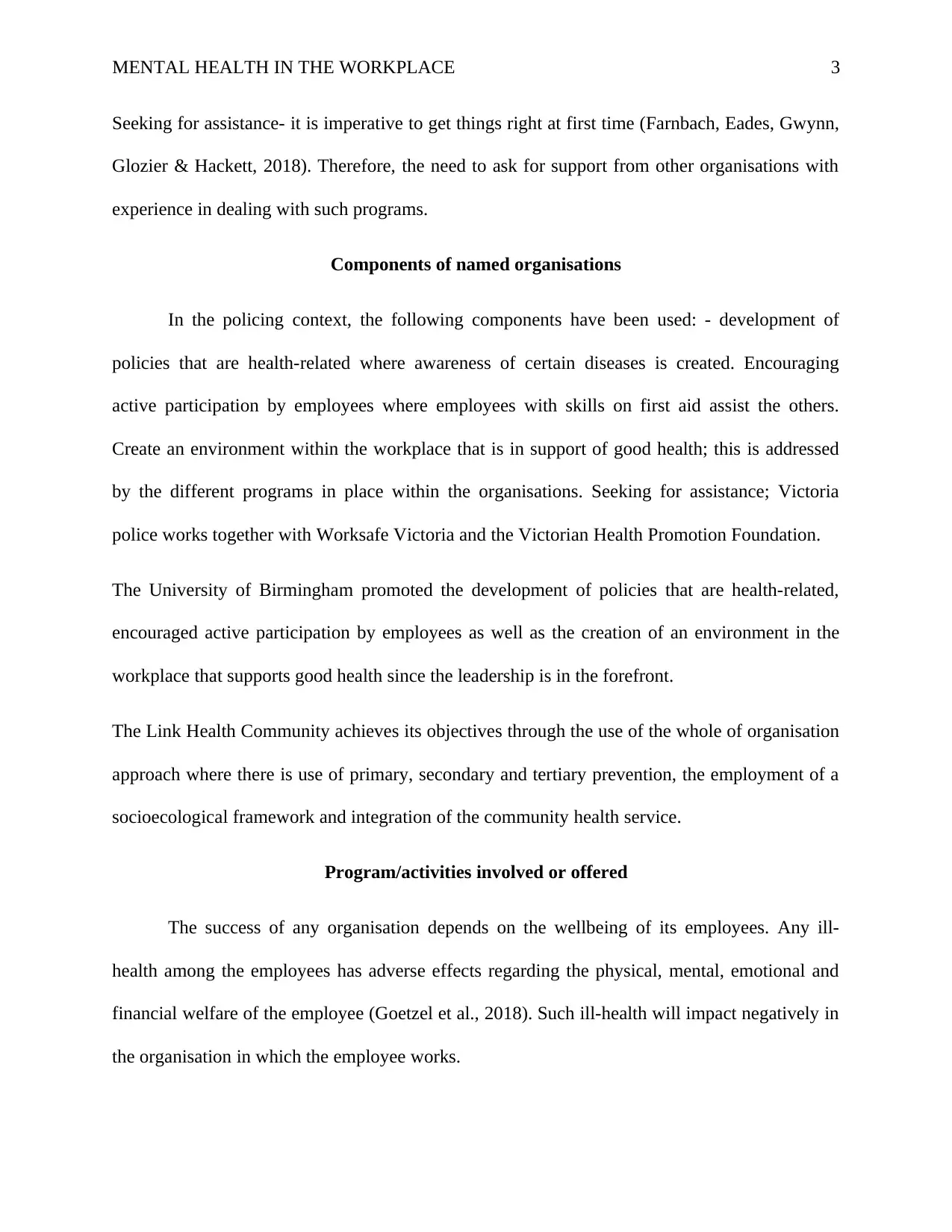
MENTAL HEALTH IN THE WORKPLACE 3
Seeking for assistance- it is imperative to get things right at first time (Farnbach, Eades, Gwynn,
Glozier & Hackett, 2018). Therefore, the need to ask for support from other organisations with
experience in dealing with such programs.
Components of named organisations
In the policing context, the following components have been used: - development of
policies that are health-related where awareness of certain diseases is created. Encouraging
active participation by employees where employees with skills on first aid assist the others.
Create an environment within the workplace that is in support of good health; this is addressed
by the different programs in place within the organisations. Seeking for assistance; Victoria
police works together with Worksafe Victoria and the Victorian Health Promotion Foundation.
The University of Birmingham promoted the development of policies that are health-related,
encouraged active participation by employees as well as the creation of an environment in the
workplace that supports good health since the leadership is in the forefront.
The Link Health Community achieves its objectives through the use of the whole of organisation
approach where there is use of primary, secondary and tertiary prevention, the employment of a
socioecological framework and integration of the community health service.
Program/activities involved or offered
The success of any organisation depends on the wellbeing of its employees. Any ill-
health among the employees has adverse effects regarding the physical, mental, emotional and
financial welfare of the employee (Goetzel et al., 2018). Such ill-health will impact negatively in
the organisation in which the employee works.
Seeking for assistance- it is imperative to get things right at first time (Farnbach, Eades, Gwynn,
Glozier & Hackett, 2018). Therefore, the need to ask for support from other organisations with
experience in dealing with such programs.
Components of named organisations
In the policing context, the following components have been used: - development of
policies that are health-related where awareness of certain diseases is created. Encouraging
active participation by employees where employees with skills on first aid assist the others.
Create an environment within the workplace that is in support of good health; this is addressed
by the different programs in place within the organisations. Seeking for assistance; Victoria
police works together with Worksafe Victoria and the Victorian Health Promotion Foundation.
The University of Birmingham promoted the development of policies that are health-related,
encouraged active participation by employees as well as the creation of an environment in the
workplace that supports good health since the leadership is in the forefront.
The Link Health Community achieves its objectives through the use of the whole of organisation
approach where there is use of primary, secondary and tertiary prevention, the employment of a
socioecological framework and integration of the community health service.
Program/activities involved or offered
The success of any organisation depends on the wellbeing of its employees. Any ill-
health among the employees has adverse effects regarding the physical, mental, emotional and
financial welfare of the employee (Goetzel et al., 2018). Such ill-health will impact negatively in
the organisation in which the employee works.
⊘ This is a preview!⊘
Do you want full access?
Subscribe today to unlock all pages.

Trusted by 1+ million students worldwide
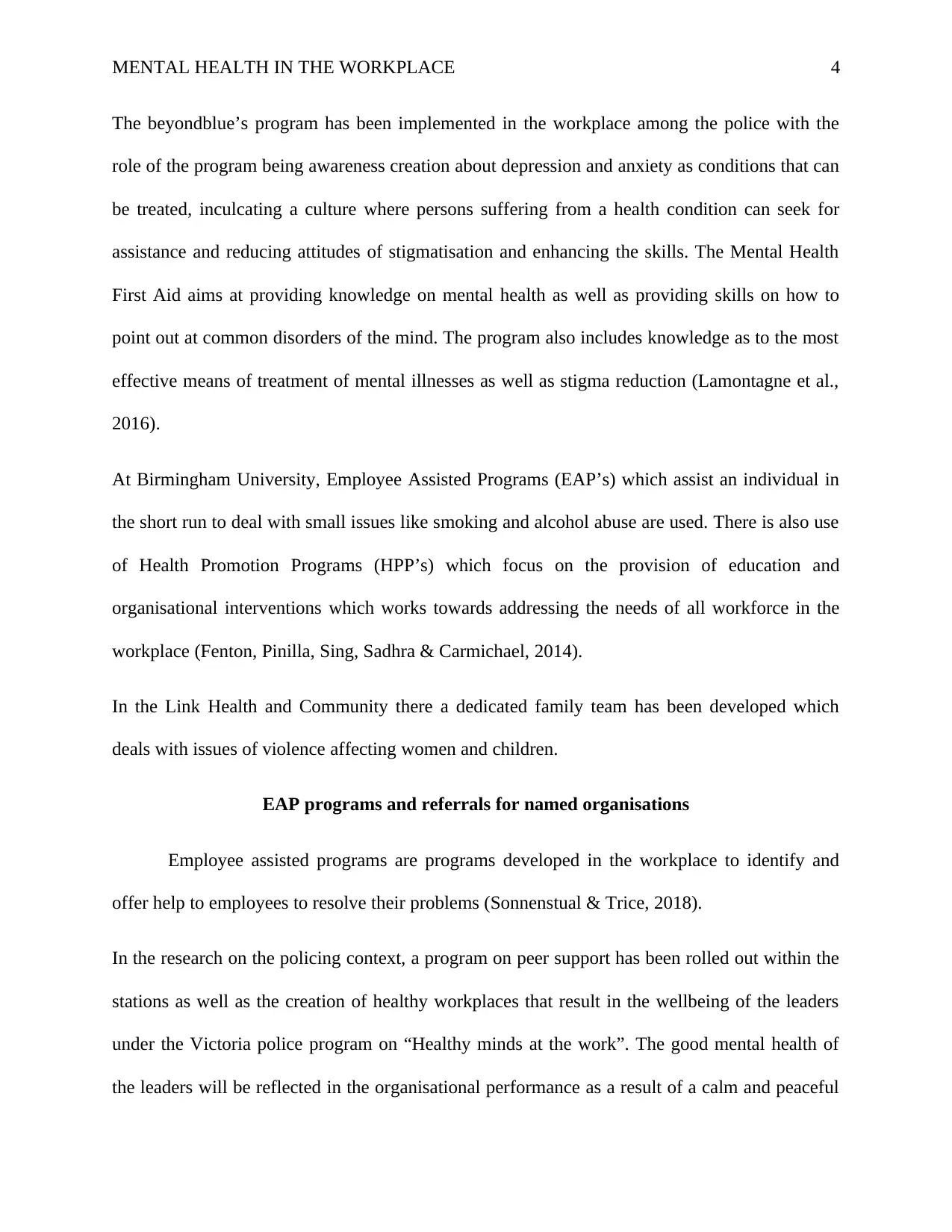
MENTAL HEALTH IN THE WORKPLACE 4
The beyondblue’s program has been implemented in the workplace among the police with the
role of the program being awareness creation about depression and anxiety as conditions that can
be treated, inculcating a culture where persons suffering from a health condition can seek for
assistance and reducing attitudes of stigmatisation and enhancing the skills. The Mental Health
First Aid aims at providing knowledge on mental health as well as providing skills on how to
point out at common disorders of the mind. The program also includes knowledge as to the most
effective means of treatment of mental illnesses as well as stigma reduction (Lamontagne et al.,
2016).
At Birmingham University, Employee Assisted Programs (EAP’s) which assist an individual in
the short run to deal with small issues like smoking and alcohol abuse are used. There is also use
of Health Promotion Programs (HPP’s) which focus on the provision of education and
organisational interventions which works towards addressing the needs of all workforce in the
workplace (Fenton, Pinilla, Sing, Sadhra & Carmichael, 2014).
In the Link Health and Community there a dedicated family team has been developed which
deals with issues of violence affecting women and children.
EAP programs and referrals for named organisations
Employee assisted programs are programs developed in the workplace to identify and
offer help to employees to resolve their problems (Sonnenstual & Trice, 2018).
In the research on the policing context, a program on peer support has been rolled out within the
stations as well as the creation of healthy workplaces that result in the wellbeing of the leaders
under the Victoria police program on “Healthy minds at the work”. The good mental health of
the leaders will be reflected in the organisational performance as a result of a calm and peaceful
The beyondblue’s program has been implemented in the workplace among the police with the
role of the program being awareness creation about depression and anxiety as conditions that can
be treated, inculcating a culture where persons suffering from a health condition can seek for
assistance and reducing attitudes of stigmatisation and enhancing the skills. The Mental Health
First Aid aims at providing knowledge on mental health as well as providing skills on how to
point out at common disorders of the mind. The program also includes knowledge as to the most
effective means of treatment of mental illnesses as well as stigma reduction (Lamontagne et al.,
2016).
At Birmingham University, Employee Assisted Programs (EAP’s) which assist an individual in
the short run to deal with small issues like smoking and alcohol abuse are used. There is also use
of Health Promotion Programs (HPP’s) which focus on the provision of education and
organisational interventions which works towards addressing the needs of all workforce in the
workplace (Fenton, Pinilla, Sing, Sadhra & Carmichael, 2014).
In the Link Health and Community there a dedicated family team has been developed which
deals with issues of violence affecting women and children.
EAP programs and referrals for named organisations
Employee assisted programs are programs developed in the workplace to identify and
offer help to employees to resolve their problems (Sonnenstual & Trice, 2018).
In the research on the policing context, a program on peer support has been rolled out within the
stations as well as the creation of healthy workplaces that result in the wellbeing of the leaders
under the Victoria police program on “Healthy minds at the work”. The good mental health of
the leaders will be reflected in the organisational performance as a result of a calm and peaceful
Paraphrase This Document
Need a fresh take? Get an instant paraphrase of this document with our AI Paraphraser
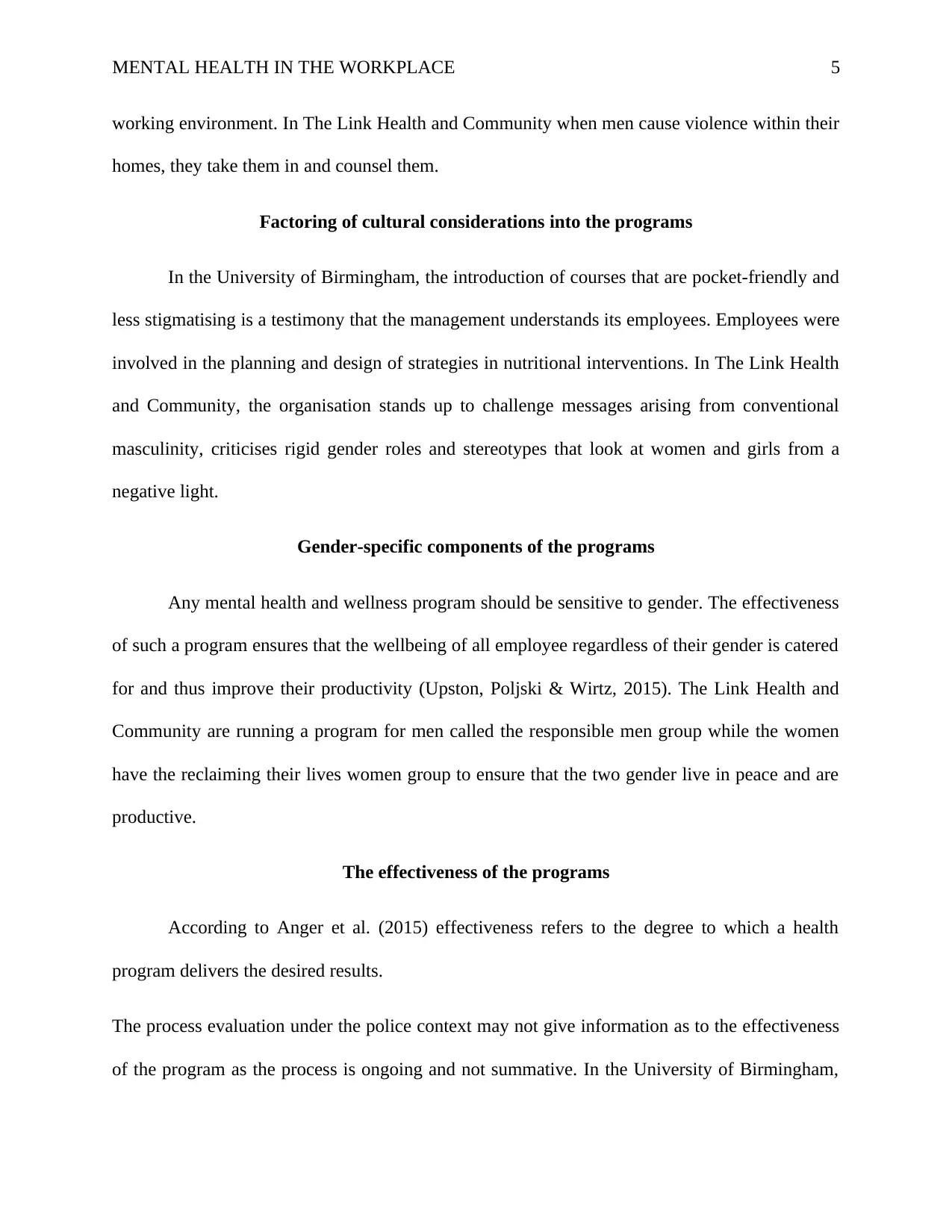
MENTAL HEALTH IN THE WORKPLACE 5
working environment. In The Link Health and Community when men cause violence within their
homes, they take them in and counsel them.
Factoring of cultural considerations into the programs
In the University of Birmingham, the introduction of courses that are pocket-friendly and
less stigmatising is a testimony that the management understands its employees. Employees were
involved in the planning and design of strategies in nutritional interventions. In The Link Health
and Community, the organisation stands up to challenge messages arising from conventional
masculinity, criticises rigid gender roles and stereotypes that look at women and girls from a
negative light.
Gender-specific components of the programs
Any mental health and wellness program should be sensitive to gender. The effectiveness
of such a program ensures that the wellbeing of all employee regardless of their gender is catered
for and thus improve their productivity (Upston, Poljski & Wirtz, 2015). The Link Health and
Community are running a program for men called the responsible men group while the women
have the reclaiming their lives women group to ensure that the two gender live in peace and are
productive.
The effectiveness of the programs
According to Anger et al. (2015) effectiveness refers to the degree to which a health
program delivers the desired results.
The process evaluation under the police context may not give information as to the effectiveness
of the program as the process is ongoing and not summative. In the University of Birmingham,
working environment. In The Link Health and Community when men cause violence within their
homes, they take them in and counsel them.
Factoring of cultural considerations into the programs
In the University of Birmingham, the introduction of courses that are pocket-friendly and
less stigmatising is a testimony that the management understands its employees. Employees were
involved in the planning and design of strategies in nutritional interventions. In The Link Health
and Community, the organisation stands up to challenge messages arising from conventional
masculinity, criticises rigid gender roles and stereotypes that look at women and girls from a
negative light.
Gender-specific components of the programs
Any mental health and wellness program should be sensitive to gender. The effectiveness
of such a program ensures that the wellbeing of all employee regardless of their gender is catered
for and thus improve their productivity (Upston, Poljski & Wirtz, 2015). The Link Health and
Community are running a program for men called the responsible men group while the women
have the reclaiming their lives women group to ensure that the two gender live in peace and are
productive.
The effectiveness of the programs
According to Anger et al. (2015) effectiveness refers to the degree to which a health
program delivers the desired results.
The process evaluation under the police context may not give information as to the effectiveness
of the program as the process is ongoing and not summative. In the University of Birmingham,
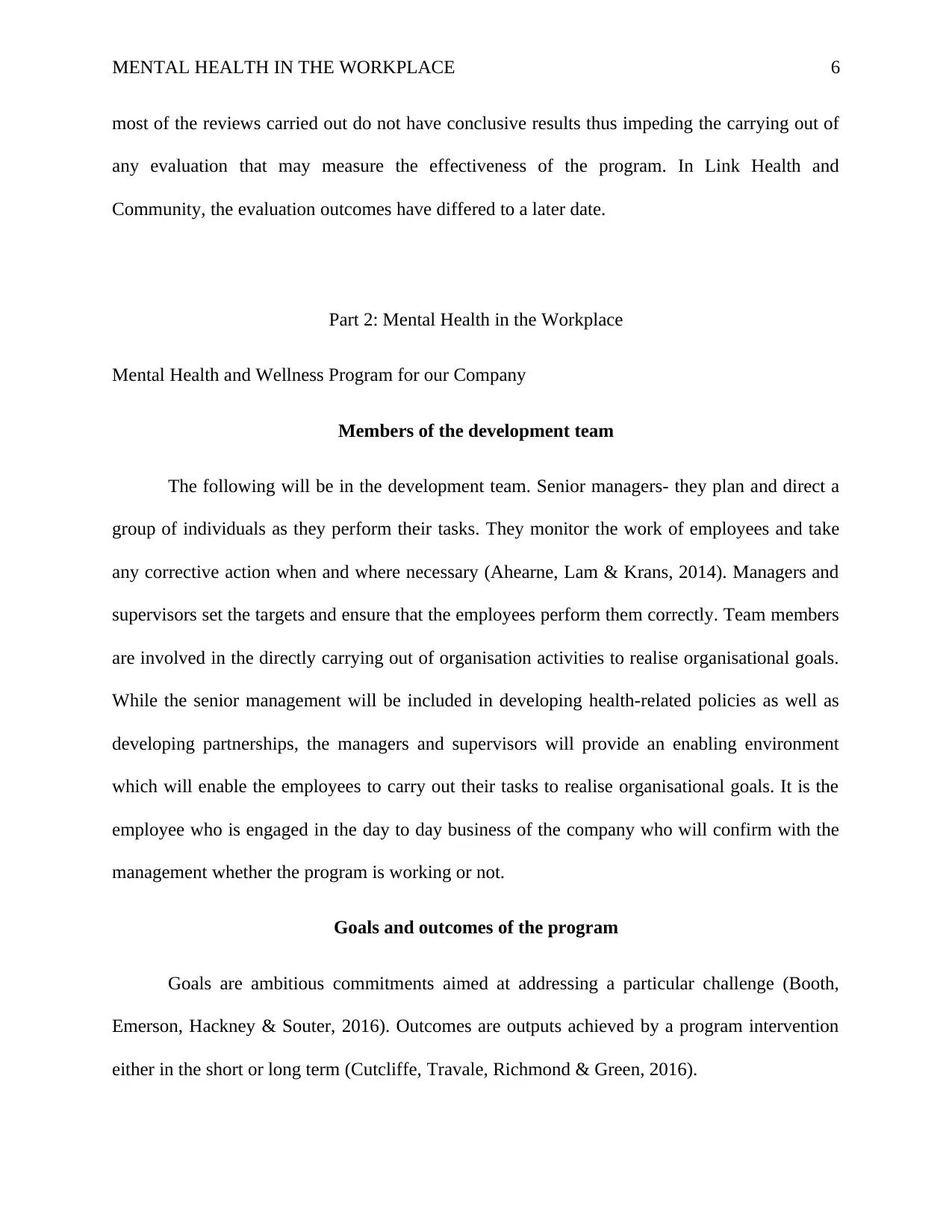
MENTAL HEALTH IN THE WORKPLACE 6
most of the reviews carried out do not have conclusive results thus impeding the carrying out of
any evaluation that may measure the effectiveness of the program. In Link Health and
Community, the evaluation outcomes have differed to a later date.
Part 2: Mental Health in the Workplace
Mental Health and Wellness Program for our Company
Members of the development team
The following will be in the development team. Senior managers- they plan and direct a
group of individuals as they perform their tasks. They monitor the work of employees and take
any corrective action when and where necessary (Ahearne, Lam & Krans, 2014). Managers and
supervisors set the targets and ensure that the employees perform them correctly. Team members
are involved in the directly carrying out of organisation activities to realise organisational goals.
While the senior management will be included in developing health-related policies as well as
developing partnerships, the managers and supervisors will provide an enabling environment
which will enable the employees to carry out their tasks to realise organisational goals. It is the
employee who is engaged in the day to day business of the company who will confirm with the
management whether the program is working or not.
Goals and outcomes of the program
Goals are ambitious commitments aimed at addressing a particular challenge (Booth,
Emerson, Hackney & Souter, 2016). Outcomes are outputs achieved by a program intervention
either in the short or long term (Cutcliffe, Travale, Richmond & Green, 2016).
most of the reviews carried out do not have conclusive results thus impeding the carrying out of
any evaluation that may measure the effectiveness of the program. In Link Health and
Community, the evaluation outcomes have differed to a later date.
Part 2: Mental Health in the Workplace
Mental Health and Wellness Program for our Company
Members of the development team
The following will be in the development team. Senior managers- they plan and direct a
group of individuals as they perform their tasks. They monitor the work of employees and take
any corrective action when and where necessary (Ahearne, Lam & Krans, 2014). Managers and
supervisors set the targets and ensure that the employees perform them correctly. Team members
are involved in the directly carrying out of organisation activities to realise organisational goals.
While the senior management will be included in developing health-related policies as well as
developing partnerships, the managers and supervisors will provide an enabling environment
which will enable the employees to carry out their tasks to realise organisational goals. It is the
employee who is engaged in the day to day business of the company who will confirm with the
management whether the program is working or not.
Goals and outcomes of the program
Goals are ambitious commitments aimed at addressing a particular challenge (Booth,
Emerson, Hackney & Souter, 2016). Outcomes are outputs achieved by a program intervention
either in the short or long term (Cutcliffe, Travale, Richmond & Green, 2016).
⊘ This is a preview!⊘
Do you want full access?
Subscribe today to unlock all pages.

Trusted by 1+ million students worldwide
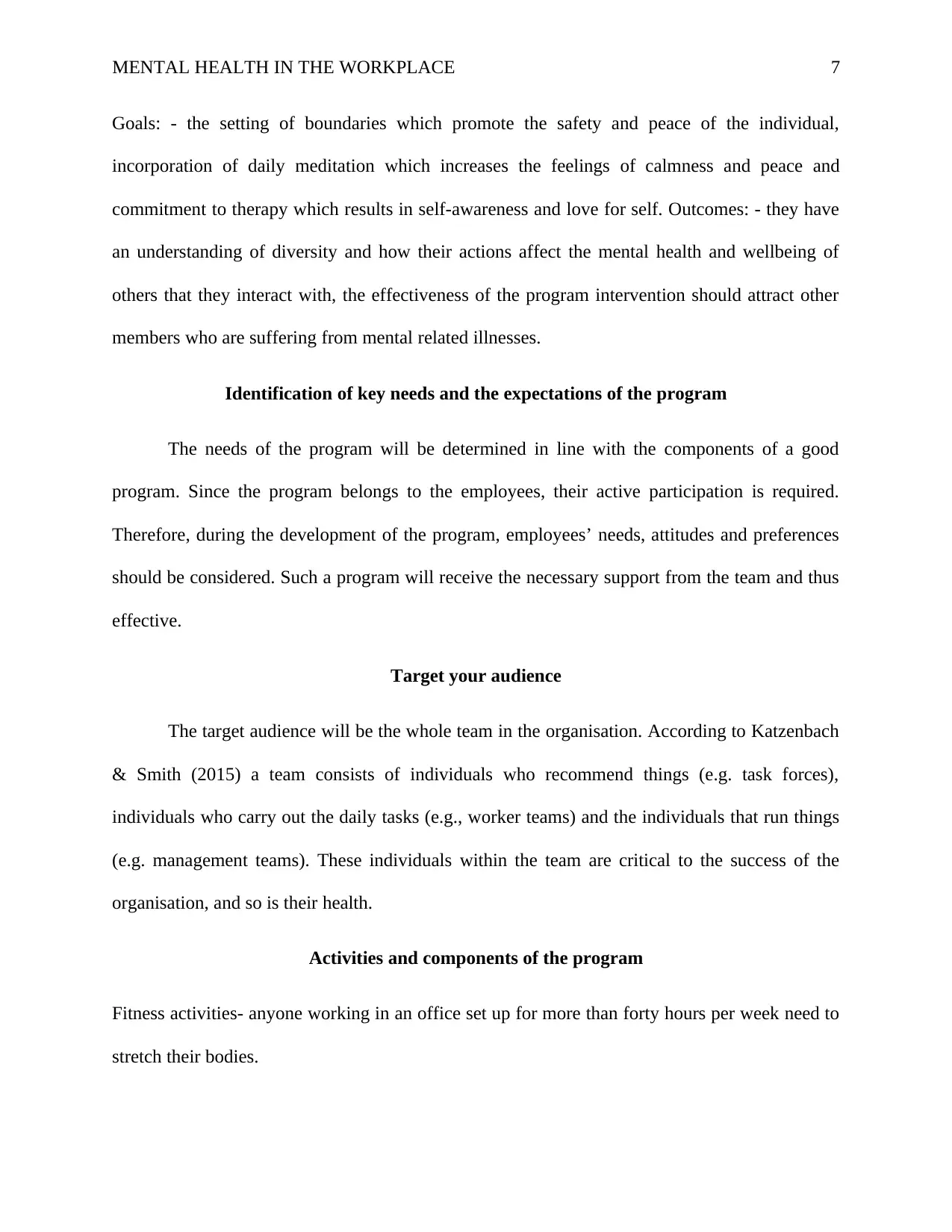
MENTAL HEALTH IN THE WORKPLACE 7
Goals: - the setting of boundaries which promote the safety and peace of the individual,
incorporation of daily meditation which increases the feelings of calmness and peace and
commitment to therapy which results in self-awareness and love for self. Outcomes: - they have
an understanding of diversity and how their actions affect the mental health and wellbeing of
others that they interact with, the effectiveness of the program intervention should attract other
members who are suffering from mental related illnesses.
Identification of key needs and the expectations of the program
The needs of the program will be determined in line with the components of a good
program. Since the program belongs to the employees, their active participation is required.
Therefore, during the development of the program, employees’ needs, attitudes and preferences
should be considered. Such a program will receive the necessary support from the team and thus
effective.
Target your audience
The target audience will be the whole team in the organisation. According to Katzenbach
& Smith (2015) a team consists of individuals who recommend things (e.g. task forces),
individuals who carry out the daily tasks (e.g., worker teams) and the individuals that run things
(e.g. management teams). These individuals within the team are critical to the success of the
organisation, and so is their health.
Activities and components of the program
Fitness activities- anyone working in an office set up for more than forty hours per week need to
stretch their bodies.
Goals: - the setting of boundaries which promote the safety and peace of the individual,
incorporation of daily meditation which increases the feelings of calmness and peace and
commitment to therapy which results in self-awareness and love for self. Outcomes: - they have
an understanding of diversity and how their actions affect the mental health and wellbeing of
others that they interact with, the effectiveness of the program intervention should attract other
members who are suffering from mental related illnesses.
Identification of key needs and the expectations of the program
The needs of the program will be determined in line with the components of a good
program. Since the program belongs to the employees, their active participation is required.
Therefore, during the development of the program, employees’ needs, attitudes and preferences
should be considered. Such a program will receive the necessary support from the team and thus
effective.
Target your audience
The target audience will be the whole team in the organisation. According to Katzenbach
& Smith (2015) a team consists of individuals who recommend things (e.g. task forces),
individuals who carry out the daily tasks (e.g., worker teams) and the individuals that run things
(e.g. management teams). These individuals within the team are critical to the success of the
organisation, and so is their health.
Activities and components of the program
Fitness activities- anyone working in an office set up for more than forty hours per week need to
stretch their bodies.
Paraphrase This Document
Need a fresh take? Get an instant paraphrase of this document with our AI Paraphraser
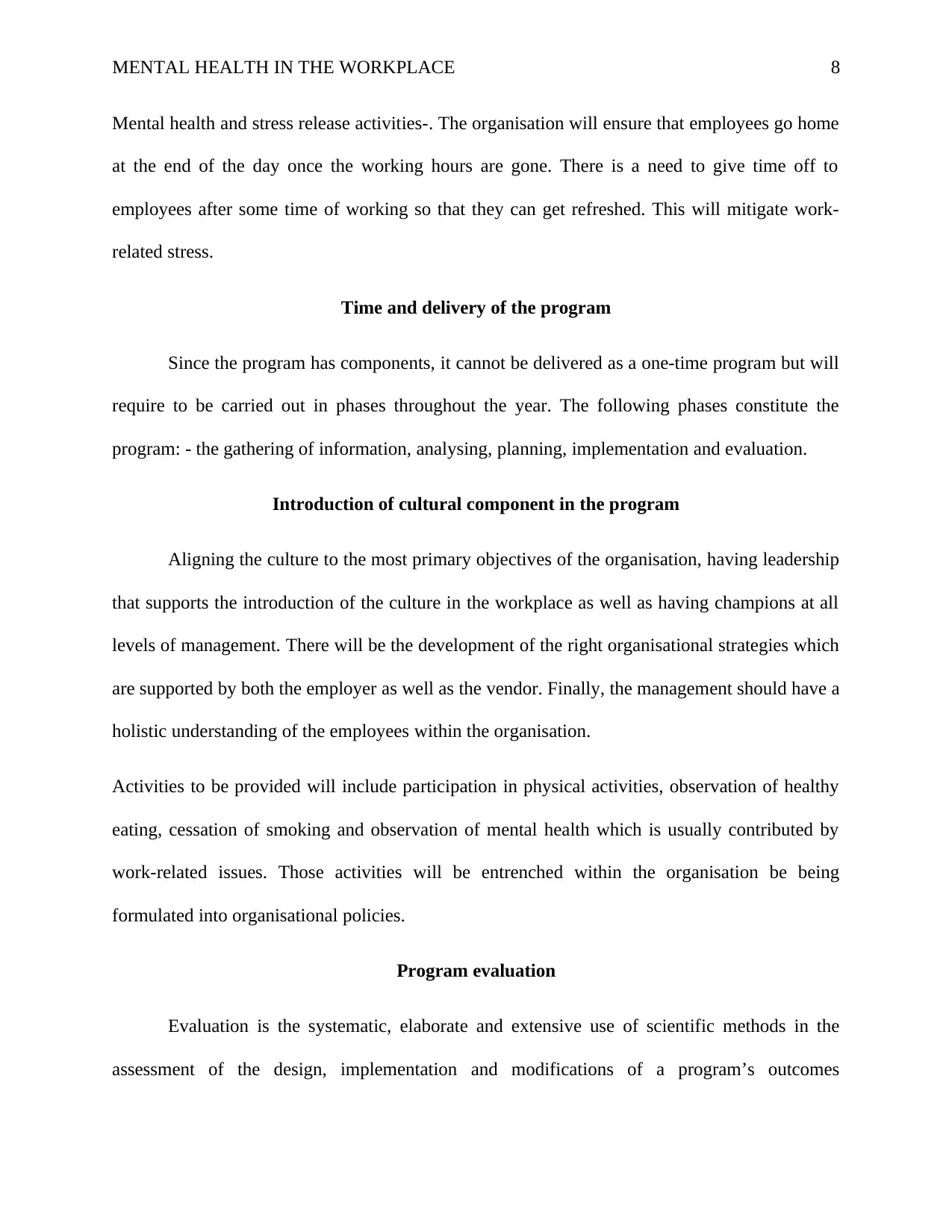
MENTAL HEALTH IN THE WORKPLACE 8
Mental health and stress release activities-. The organisation will ensure that employees go home
at the end of the day once the working hours are gone. There is a need to give time off to
employees after some time of working so that they can get refreshed. This will mitigate work-
related stress.
Time and delivery of the program
Since the program has components, it cannot be delivered as a one-time program but will
require to be carried out in phases throughout the year. The following phases constitute the
program: - the gathering of information, analysing, planning, implementation and evaluation.
Introduction of cultural component in the program
Aligning the culture to the most primary objectives of the organisation, having leadership
that supports the introduction of the culture in the workplace as well as having champions at all
levels of management. There will be the development of the right organisational strategies which
are supported by both the employer as well as the vendor. Finally, the management should have a
holistic understanding of the employees within the organisation.
Activities to be provided will include participation in physical activities, observation of healthy
eating, cessation of smoking and observation of mental health which is usually contributed by
work-related issues. Those activities will be entrenched within the organisation be being
formulated into organisational policies.
Program evaluation
Evaluation is the systematic, elaborate and extensive use of scientific methods in the
assessment of the design, implementation and modifications of a program’s outcomes
Mental health and stress release activities-. The organisation will ensure that employees go home
at the end of the day once the working hours are gone. There is a need to give time off to
employees after some time of working so that they can get refreshed. This will mitigate work-
related stress.
Time and delivery of the program
Since the program has components, it cannot be delivered as a one-time program but will
require to be carried out in phases throughout the year. The following phases constitute the
program: - the gathering of information, analysing, planning, implementation and evaluation.
Introduction of cultural component in the program
Aligning the culture to the most primary objectives of the organisation, having leadership
that supports the introduction of the culture in the workplace as well as having champions at all
levels of management. There will be the development of the right organisational strategies which
are supported by both the employer as well as the vendor. Finally, the management should have a
holistic understanding of the employees within the organisation.
Activities to be provided will include participation in physical activities, observation of healthy
eating, cessation of smoking and observation of mental health which is usually contributed by
work-related issues. Those activities will be entrenched within the organisation be being
formulated into organisational policies.
Program evaluation
Evaluation is the systematic, elaborate and extensive use of scientific methods in the
assessment of the design, implementation and modifications of a program’s outcomes
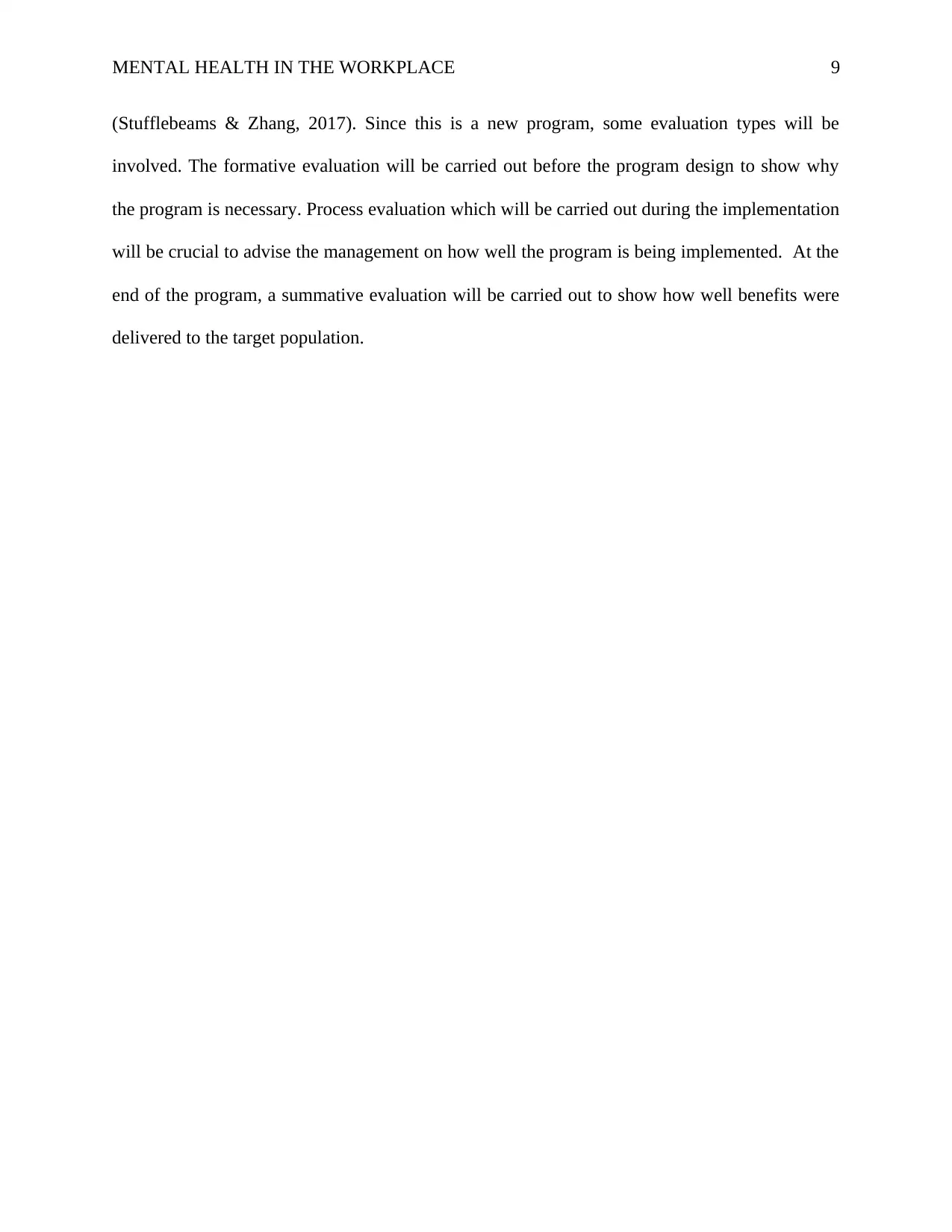
MENTAL HEALTH IN THE WORKPLACE 9
(Stufflebeams & Zhang, 2017). Since this is a new program, some evaluation types will be
involved. The formative evaluation will be carried out before the program design to show why
the program is necessary. Process evaluation which will be carried out during the implementation
will be crucial to advise the management on how well the program is being implemented. At the
end of the program, a summative evaluation will be carried out to show how well benefits were
delivered to the target population.
(Stufflebeams & Zhang, 2017). Since this is a new program, some evaluation types will be
involved. The formative evaluation will be carried out before the program design to show why
the program is necessary. Process evaluation which will be carried out during the implementation
will be crucial to advise the management on how well the program is being implemented. At the
end of the program, a summative evaluation will be carried out to show how well benefits were
delivered to the target population.
⊘ This is a preview!⊘
Do you want full access?
Subscribe today to unlock all pages.

Trusted by 1+ million students worldwide
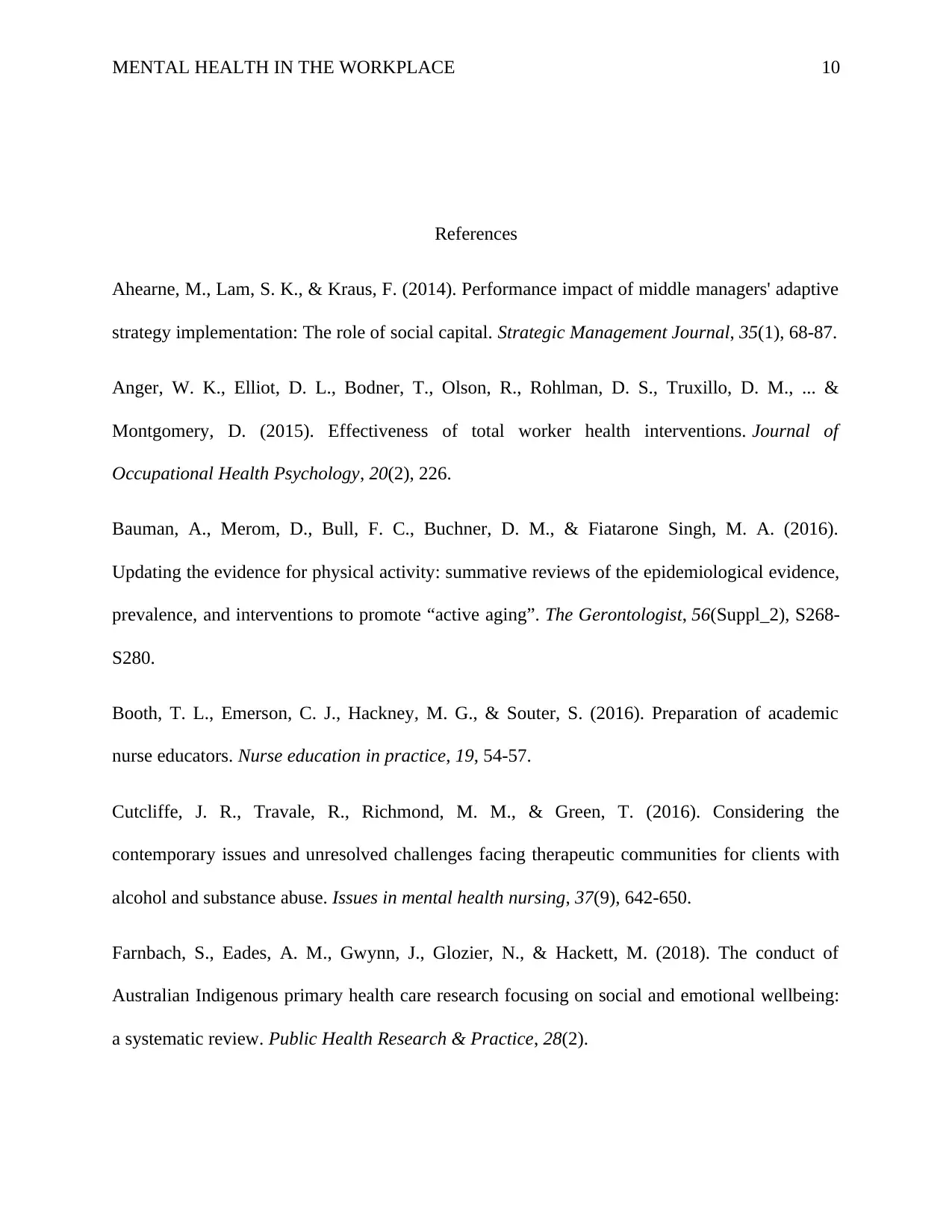
MENTAL HEALTH IN THE WORKPLACE 10
References
Ahearne, M., Lam, S. K., & Kraus, F. (2014). Performance impact of middle managers' adaptive
strategy implementation: The role of social capital. Strategic Management Journal, 35(1), 68-87.
Anger, W. K., Elliot, D. L., Bodner, T., Olson, R., Rohlman, D. S., Truxillo, D. M., ... &
Montgomery, D. (2015). Effectiveness of total worker health interventions. Journal of
Occupational Health Psychology, 20(2), 226.
Bauman, A., Merom, D., Bull, F. C., Buchner, D. M., & Fiatarone Singh, M. A. (2016).
Updating the evidence for physical activity: summative reviews of the epidemiological evidence,
prevalence, and interventions to promote “active aging”. The Gerontologist, 56(Suppl_2), S268-
S280.
Booth, T. L., Emerson, C. J., Hackney, M. G., & Souter, S. (2016). Preparation of academic
nurse educators. Nurse education in practice, 19, 54-57.
Cutcliffe, J. R., Travale, R., Richmond, M. M., & Green, T. (2016). Considering the
contemporary issues and unresolved challenges facing therapeutic communities for clients with
alcohol and substance abuse. Issues in mental health nursing, 37(9), 642-650.
Farnbach, S., Eades, A. M., Gwynn, J., Glozier, N., & Hackett, M. (2018). The conduct of
Australian Indigenous primary health care research focusing on social and emotional wellbeing:
a systematic review. Public Health Research & Practice, 28(2).
References
Ahearne, M., Lam, S. K., & Kraus, F. (2014). Performance impact of middle managers' adaptive
strategy implementation: The role of social capital. Strategic Management Journal, 35(1), 68-87.
Anger, W. K., Elliot, D. L., Bodner, T., Olson, R., Rohlman, D. S., Truxillo, D. M., ... &
Montgomery, D. (2015). Effectiveness of total worker health interventions. Journal of
Occupational Health Psychology, 20(2), 226.
Bauman, A., Merom, D., Bull, F. C., Buchner, D. M., & Fiatarone Singh, M. A. (2016).
Updating the evidence for physical activity: summative reviews of the epidemiological evidence,
prevalence, and interventions to promote “active aging”. The Gerontologist, 56(Suppl_2), S268-
S280.
Booth, T. L., Emerson, C. J., Hackney, M. G., & Souter, S. (2016). Preparation of academic
nurse educators. Nurse education in practice, 19, 54-57.
Cutcliffe, J. R., Travale, R., Richmond, M. M., & Green, T. (2016). Considering the
contemporary issues and unresolved challenges facing therapeutic communities for clients with
alcohol and substance abuse. Issues in mental health nursing, 37(9), 642-650.
Farnbach, S., Eades, A. M., Gwynn, J., Glozier, N., & Hackett, M. (2018). The conduct of
Australian Indigenous primary health care research focusing on social and emotional wellbeing:
a systematic review. Public Health Research & Practice, 28(2).
Paraphrase This Document
Need a fresh take? Get an instant paraphrase of this document with our AI Paraphraser
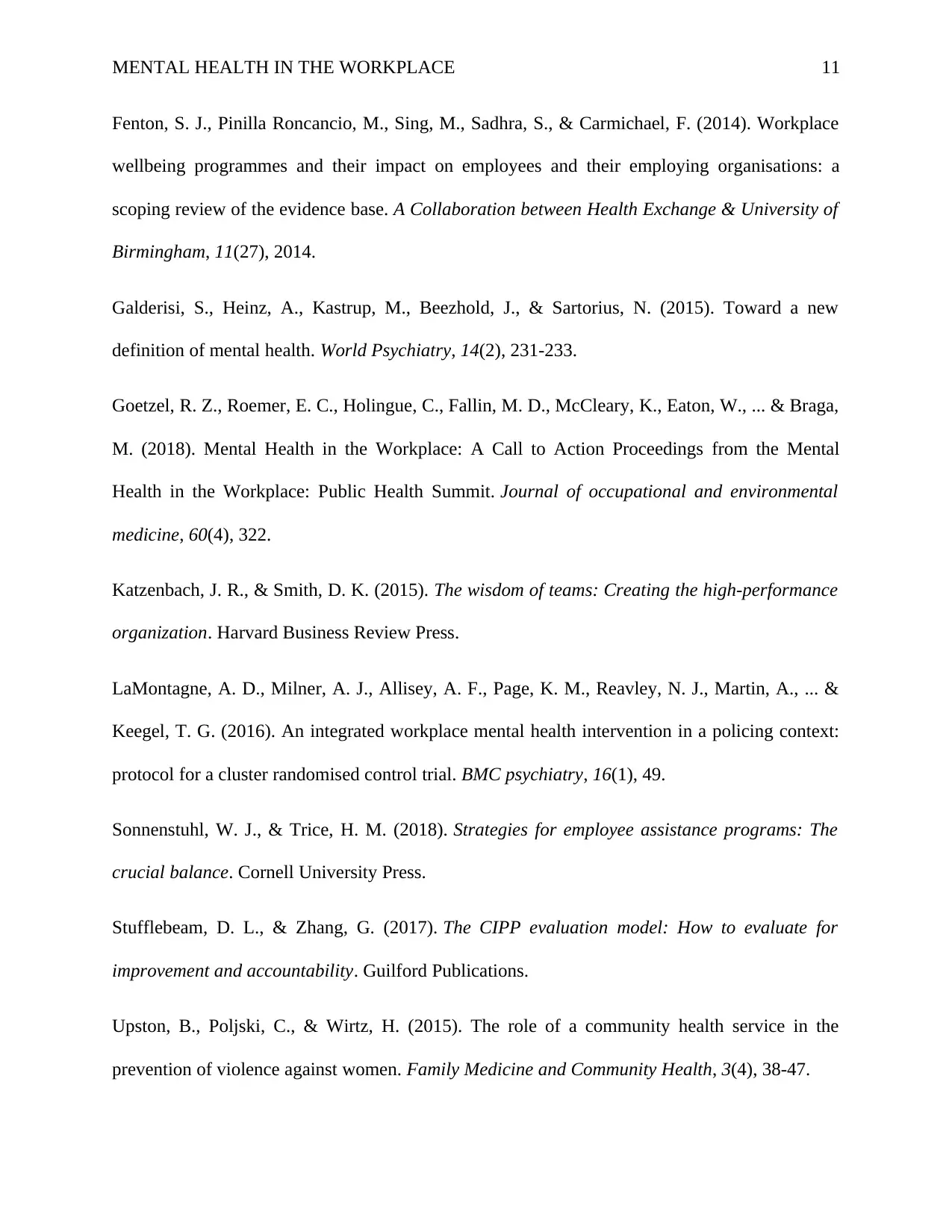
MENTAL HEALTH IN THE WORKPLACE 11
Fenton, S. J., Pinilla Roncancio, M., Sing, M., Sadhra, S., & Carmichael, F. (2014). Workplace
wellbeing programmes and their impact on employees and their employing organisations: a
scoping review of the evidence base. A Collaboration between Health Exchange & University of
Birmingham, 11(27), 2014.
Galderisi, S., Heinz, A., Kastrup, M., Beezhold, J., & Sartorius, N. (2015). Toward a new
definition of mental health. World Psychiatry, 14(2), 231-233.
Goetzel, R. Z., Roemer, E. C., Holingue, C., Fallin, M. D., McCleary, K., Eaton, W., ... & Braga,
M. (2018). Mental Health in the Workplace: A Call to Action Proceedings from the Mental
Health in the Workplace: Public Health Summit. Journal of occupational and environmental
medicine, 60(4), 322.
Katzenbach, J. R., & Smith, D. K. (2015). The wisdom of teams: Creating the high-performance
organization. Harvard Business Review Press.
LaMontagne, A. D., Milner, A. J., Allisey, A. F., Page, K. M., Reavley, N. J., Martin, A., ... &
Keegel, T. G. (2016). An integrated workplace mental health intervention in a policing context:
protocol for a cluster randomised control trial. BMC psychiatry, 16(1), 49.
Sonnenstuhl, W. J., & Trice, H. M. (2018). Strategies for employee assistance programs: The
crucial balance. Cornell University Press.
Stufflebeam, D. L., & Zhang, G. (2017). The CIPP evaluation model: How to evaluate for
improvement and accountability. Guilford Publications.
Upston, B., Poljski, C., & Wirtz, H. (2015). The role of a community health service in the
prevention of violence against women. Family Medicine and Community Health, 3(4), 38-47.
Fenton, S. J., Pinilla Roncancio, M., Sing, M., Sadhra, S., & Carmichael, F. (2014). Workplace
wellbeing programmes and their impact on employees and their employing organisations: a
scoping review of the evidence base. A Collaboration between Health Exchange & University of
Birmingham, 11(27), 2014.
Galderisi, S., Heinz, A., Kastrup, M., Beezhold, J., & Sartorius, N. (2015). Toward a new
definition of mental health. World Psychiatry, 14(2), 231-233.
Goetzel, R. Z., Roemer, E. C., Holingue, C., Fallin, M. D., McCleary, K., Eaton, W., ... & Braga,
M. (2018). Mental Health in the Workplace: A Call to Action Proceedings from the Mental
Health in the Workplace: Public Health Summit. Journal of occupational and environmental
medicine, 60(4), 322.
Katzenbach, J. R., & Smith, D. K. (2015). The wisdom of teams: Creating the high-performance
organization. Harvard Business Review Press.
LaMontagne, A. D., Milner, A. J., Allisey, A. F., Page, K. M., Reavley, N. J., Martin, A., ... &
Keegel, T. G. (2016). An integrated workplace mental health intervention in a policing context:
protocol for a cluster randomised control trial. BMC psychiatry, 16(1), 49.
Sonnenstuhl, W. J., & Trice, H. M. (2018). Strategies for employee assistance programs: The
crucial balance. Cornell University Press.
Stufflebeam, D. L., & Zhang, G. (2017). The CIPP evaluation model: How to evaluate for
improvement and accountability. Guilford Publications.
Upston, B., Poljski, C., & Wirtz, H. (2015). The role of a community health service in the
prevention of violence against women. Family Medicine and Community Health, 3(4), 38-47.

MENTAL HEALTH IN THE WORKPLACE 12
⊘ This is a preview!⊘
Do you want full access?
Subscribe today to unlock all pages.

Trusted by 1+ million students worldwide
1 out of 12
Related Documents
Your All-in-One AI-Powered Toolkit for Academic Success.
+13062052269
info@desklib.com
Available 24*7 on WhatsApp / Email
![[object Object]](/_next/static/media/star-bottom.7253800d.svg)
Unlock your academic potential
Copyright © 2020–2025 A2Z Services. All Rights Reserved. Developed and managed by ZUCOL.




